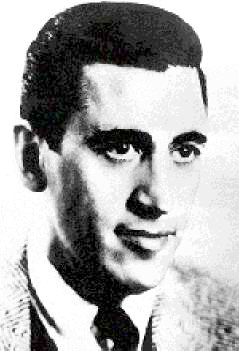Издателство |
| :. Издателство
LiterNet |
Медии |
| :. Електронно списание LiterNet |
| :. Електронно списание БЕЛ |
| :. Културни
новини |
Каталози |
| :. По
дати : Март |
| :. Електронни книги |
| :. Раздели / Рубрики |
| :. Автори |
| :. Критика за авторите |
Книжарници |
| :. Книжен
пазар |
| :. Книгосвят: сравни цени |
Ресурси |
| :. Каталог за култура |
| :. Артзона |
| :. Писмена реч |
За
нас |
| :. Всичко за LiterNet |
J. D. SALINGER
(1919-2010)
 J.
D. Salinger (Jerome David Salinger) was born in New York City in 1919 to Sol
and Miriam Jillich Salinger (his father was Jewish; his mother, Scotch Irish).
He has a sister Doris 8 years his senior. He attended public schools on Manhattan's
upper West Side, the private McBurney School in Manhattan, and then Valley Forge
Military Academy in Pennsylvania, from which he graduated in 1936. His college
experience was brief: a summer session at New York University, a short-story
writing class at Columbia University taught by Whit Burnett, co-editor of Story,
and a short period at Ursinus College in Pennsylvania.
J.
D. Salinger (Jerome David Salinger) was born in New York City in 1919 to Sol
and Miriam Jillich Salinger (his father was Jewish; his mother, Scotch Irish).
He has a sister Doris 8 years his senior. He attended public schools on Manhattan's
upper West Side, the private McBurney School in Manhattan, and then Valley Forge
Military Academy in Pennsylvania, from which he graduated in 1936. His college
experience was brief: a summer session at New York University, a short-story
writing class at Columbia University taught by Whit Burnett, co-editor of Story,
and a short period at Ursinus College in Pennsylvania.
Of further biographical note is his military service during World War II, including counter-intelligence training in Devonshire, England (the setting for part of "For Esme-with Love and Squalor")
In 1955 he married Claire Douglas; they have a daughter and a son.
Salinger is noted for what has been called a "reverse exhibitionism," that is, a determination to keep his life private.
By 1941, when he was 22, Salinger was publishing in well-paying magazines such as Collier's and Esquire.
It was in 1948 that he began to find real recognition, with the publication of three stories which later were to appear in the collection, Nine Stories: "A Perfect Day for Bananafish," "Uncle Wiggily in Connecticut," and "Just Before the War with the Eskimos," all appearing in the New Yorker, certainly a prestigious sign. In 1949 and 1950 three more stories from his collection were published - "The Laughing Man," "Down at the Dinghy," and "For Esme - with Love and Squalor."
The Catcher in the Rye became upon publication in 1951 what might be termed an almost-immediate success.
=============================
© E-publisher LiterNet, 10.04.2010
The Sun Is but a Morning Star. Anthology of American Literature. Edited by Albena
Bakratcheva. Varna: LiterNet, 2008-2010
